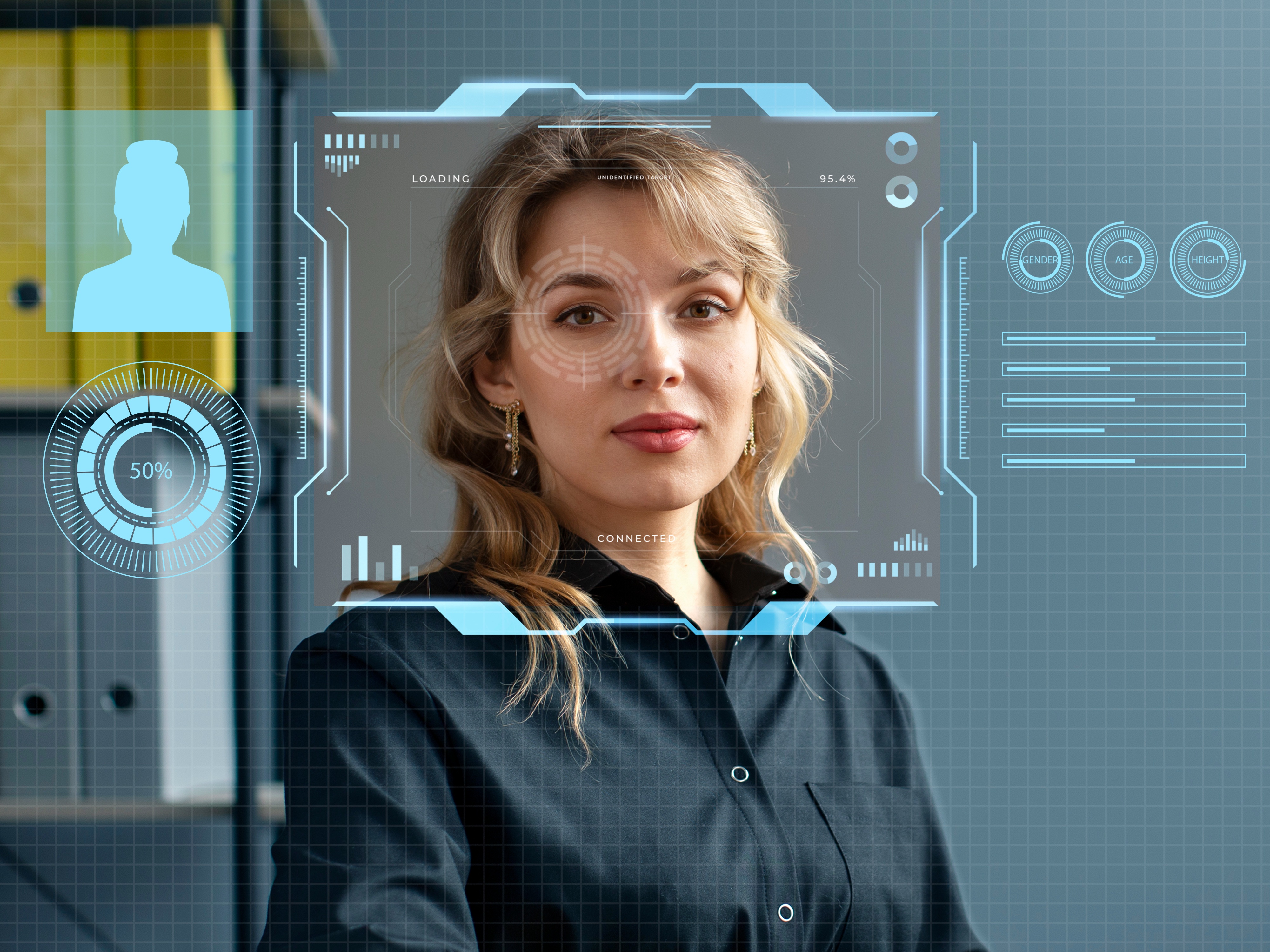
Face Recognition Trends for 2025
Looking ahead, 2025 is poised to be a milestone year for face recognition technology. Several factors will come together to push this technology to new heights, making it more accurate, accessible, and reliable than ever before.
What makes 2025 so pivotal? It’s not just the continued evolution of existing technologies, but the convergence of multiple breakthroughs that promise to create new possibilities and solutions across various sectors. As AI, automation, and digital transformation continue to mature, industries from healthcare and finance to retail and transportation will experience profound shifts. These changes will bring with them both new opportunities and challenges, requiring businesses and individuals to adapt to an ever-evolving landscape.
In this context, 2025 stands as a milestone year — one where we can expect to see a deeper integration of advanced technologies into our daily lives, accompanied by advancements in regulation, ethical frameworks, and security measures. The year will serve as a defining moment, with technology driving innovation forward at an unprecedented scale. Whether it’s the rise of AI-powered systems, the mainstreaming of blockchain, or the widespread adoption of biometric solutions, 2025 will undoubtedly be a year that sets the stage for the next chapter of technological progress.
Enhanced Accuracy and Speed in Face Recognition Systems

Face recognition technology has come a long way, thanks to remarkable advancements in artificial intelligence (AI) and machine learning. As we look ahead to 2025, these innovations are set to elevate the accuracy and speed of face recognition systems to new heights, reshaping industries and enhancing user experiences worldwide.
One of the most significant improvements in recent years is the increased precision of face recognition algorithms. AI-powered systems now leverage deep learning techniques, particularly convolutional neural networks (CNNs), to analyze facial features with unprecedented detail. These advanced models can identify even the subtlest facial characteristics, improving accuracy in diverse conditions—whether it’s varying lighting, facial expressions, or angles. This leap in precision has reduced the margin of error significantly, making face recognition systems far more reliable.
Speed is another key area where AI and machine learning have made an impactful difference. With the use of optimized algorithms and powerful processing capabilities, modern face recognition systems can process and match faces in real time. This rapid processing is crucial for applications that demand quick verification, such as security systems at airports or mobile device authentication. The ability to scan and recognize faces almost instantaneously has made these systems highly efficient, reducing waiting times and enhancing user satisfaction.
Moreover, AI’s ability to adapt and improve over time plays a crucial role in the ongoing evolution of face recognition technology. As these systems process more data, they become better at handling edge cases, such as poor-quality images or partial faces. This continuous learning process ensures that the systems stay accurate and reliable, even as they encounter new and diverse scenarios.
The combined advancements in accuracy and speed not only optimize security systems but also unlock new opportunities across various industries, from personalized customer experiences in retail to seamless authentication in finance and healthcare. As AI and machine learning continue to evolve, we can expect face recognition systems to become more intuitive, adaptive, and indispensable in our daily lives.
Integration in Mobile Devices and Smart Home Technology
As technology continues to advance, face recognition is increasingly becoming an integral part of the digital experience, especially in mobile devices and smart home technology. By seamlessly blending convenience, security, and personalization, these innovations are transforming the way we interact with our devices and environments.
In mobile devices, face recognition has revolutionized security features, offering a faster and more intuitive alternative to traditional PINs or passwords. Modern smartphones are equipped with sophisticated cameras and sensors that work in conjunction with AI-powered algorithms to recognize a user's face in a matter of seconds. Whether unlocking a phone, authorizing payments, or logging into apps, face recognition provides a level of convenience that traditional methods cannot match. The technology’s ability to differentiate between real faces and photos or videos adds an extra layer of security, making it a trusted method for personal device authentication.
Beyond basic security, face recognition is enhancing the overall mobile user experience. It enables personalized features, such as adjusting settings based on who is holding the device. For example, a phone could automatically switch to a specific user profile, display customized notifications, or even adjust display brightness depending on the recognized user. This seamless interaction between face recognition and mobile technology brings a new level of personalization that users are coming to expect.
Smart home technology is another area where face recognition is making significant strides. With the rise of smart devices like thermostats, security cameras, and voice assistants, integrating face recognition adds an additional layer of intelligence and automation to our living spaces. For instance, smart security systems can recognize household members and grant them access while alerting homeowners to unfamiliar faces. This enhances both security and convenience, eliminating the need for physical keys or codes.
Moreover, face recognition in smart homes can be used to trigger personalized experiences. Imagine walking into your home and having the thermostat adjust to your preferred temperature, the lights automatically turn on, and your favorite playlist begin to play—all based on the recognition of your face. As AI technology continues to evolve, these systems will only become more refined, learning your preferences and adapting to your behavior over time.
The integration of face recognition in mobile devices and smart home technology not only streamlines everyday tasks but also enhances the safety, comfort, and convenience of our connected lives. As the technology continues to evolve, the possibilities for creating smarter, more intuitive environments are endless, making face recognition a cornerstone of the next wave of innovation in personal technology.

Personalized User Experiences in Retail and E-Commerce
In the world of retail and e-commerce, delivering personalized user experiences has become a key factor in standing out from the competition. Face recognition technology is playing an increasingly important role in this transformation, enabling businesses to tailor their offerings to individual customers in ways that were once unimaginable.
At the heart of this personalization is the ability of face recognition systems to gather valuable insights about customers as they interact with retail environments or online platforms. In physical stores, face recognition can be used to identify returning customers and instantly pull up their preferences, purchase history, or loyalty status. This allows staff to offer personalized assistance or send targeted promotions to enhance the shopping experience. Imagine walking into a store and being greeted by name, with sales associates offering tailored recommendations based on your previous shopping habits or preferences.
In e-commerce, face recognition takes personalization to the next level by creating a more intuitive and seamless online shopping experience. By analyzing facial features and expressions, these systems can detect mood or reactions during browsing, allowing websites to adapt in real time. For example, if a user looks at a particular product with interest or seems frustrated during a checkout process, the website can suggest related items, offer discounts, or make adjustments to the layout to improve engagement. This immediate, adaptive response makes online shopping feel more interactive and responsive, mimicking the personal attention one might receive in a brick-and-mortar store.
Furthermore, face recognition can enhance personalized marketing campaigns. By analyzing demographic data and facial features, retailers can tailor advertisements to specific segments, ensuring that content resonates with each viewer. In addition, customers can enjoy customized offers based on their shopping habits and preferences, increasing the likelihood of conversion. Whether it’s suggesting new arrivals, sending personalized discounts, or recommending complementary products, the integration of face recognition makes every interaction more relevant and engaging.
The benefits of using face recognition in retail and e-commerce go beyond just improving the shopping experience—they also drive customer loyalty and boost sales. By consistently offering tailored experiences that cater to individual preferences, businesses can foster stronger connections with customers, leading to increased satisfaction, repeat visits, and long-term loyalty.
Facial Recognition for Contactless Transactions
In today’s fast-paced world, convenience and security are paramount, especially when it comes to making payments. Facial recognition technology is revolutionizing the way we approach financial transactions, offering a seamless and secure way to pay without the need for physical contact or even a device in hand.
The integration of facial recognition into contactless transactions has made it easier than ever for consumers to complete purchases with just a glance. By simply looking at a camera or scanning their face, users can authorize payments quickly and securely. This frictionless experience eliminates the need for cash, credit cards, or even smartphones, creating a smoother, faster checkout process—whether at a retail store, restaurant, or online platform.
Security is a major advantage of facial recognition in payment systems. Unlike traditional methods, such as PIN codes or signatures, facial recognition is much harder to replicate or steal. The unique patterns of a person’s face—often including thousands of data points—make it an extremely secure form of biometric identification. Additionally, modern systems use liveness detection to ensure that the facial scan is coming from a real person and not a photo or video, further reducing the risk of fraud.
This technology is particularly valuable in the context of contactless transactions, which have surged in popularity due to health and hygiene concerns. In environments like airports, public transport systems, or retail spaces, facial recognition allows for a truly contactless experience, reducing physical interactions and enhancing both safety and convenience. Consumers can walk up to a kiosk, look into a camera, and complete a payment without touching a single button.
For businesses, adopting facial recognition for transactions can improve efficiency and customer satisfaction. It speeds up the checkout process, helping to reduce long lines and waiting times, particularly in high-traffic areas. This not only enhances the customer experience but also streamlines operations for retailers and service providers. Furthermore, the ability to easily integrate facial recognition into existing payment systems can make the transition to contactless transactions relatively straightforward.
As the technology becomes more widespread, the potential for facial recognition to redefine the payment landscape is immense. It’s not just about replacing traditional payment methods—it’s about offering a new level of convenience, security, and speed that meets the demands of modern consumers.
Liveness Detection to Prevent Fraud
As face recognition technology becomes more prevalent, ensuring the security and authenticity of biometric systems is more critical than ever. One of the most significant advancements in combating fraud is the integration of liveness detection, a technology designed to confirm that a face scan is being conducted in real-time by a living person, rather than a photo, video, or other static image.
Liveness detection adds an extra layer of protection by analyzing subtle, dynamic behaviors that are impossible to replicate with inanimate objects. This might include detecting facial movements, eye blinks, or subtle shifts in lighting. In real-time authentication processes, like mobile phone unlocking or secure transactions, these small but vital signs help confirm that the face being scanned is not a pre-recorded image but an actual person. This ensures that attackers cannot bypass security measures by using photos or digital representations.
The implementation of liveness detection has become an essential tool in preventing fraud, especially in sectors where security is paramount—such as banking, e-commerce, and government services. For instance, in online banking, users can safely perform high-stakes transactions, knowing that their identity is protected not just by facial recognition but by liveness detection that confirms the presence of a genuine individual. Similarly, in the world of remote identity verification, such as during account sign-ups or logins, it significantly reduces the risk of identity theft or spoofing.
As we look towards 2025, liveness detection is expected to evolve alongside advances in AI and machine learning, offering even more sophisticated fraud prevention techniques. Future systems may use multi-factor approaches to ensure the highest levels of security—combining face recognition, liveness detection, and additional behavioral biometrics like voice recognition or gait analysis. The more layers of authentication, the harder it becomes for fraudsters to penetrate the system.
The rise of liveness detection will also play a pivotal role in regulatory compliance, as governments and organizations around the world continue to tighten privacy laws and data protection requirements. By incorporating liveness detection, businesses can demonstrate their commitment to safeguarding user data and providing secure, fraud-resistant systems.
Looking ahead, the fusion of face recognition and liveness detection will be a defining trend in 2025. These technologies, together, promise to create not only more secure but also more seamless user experiences. From reducing fraud to improving trust in biometric systems, liveness detection will continue to be a key player in shaping the future of digital security.
Blockchain Integration for Secure Storage of Biometric Data
As face recognition technology becomes increasingly embedded in daily life, the need for secure and ethical handling of biometric data has never been more pressing. In response to rising concerns about privacy and data security, blockchain technology is emerging as a key player in ensuring the safe storage and management of sensitive biometric information. By combining the strengths of blockchain with face recognition systems, we can expect a major shift in how biometric data is stored, shared, and protected in 2025.
At its core, blockchain is a decentralized, transparent, and immutable ledger system. This means that any data recorded on a blockchain cannot be altered or tampered with without the consensus of the network, offering an unparalleled level of security. By integrating blockchain with face recognition systems, biometric data—such as facial scans—can be securely encrypted and stored in a distributed manner, making it virtually impossible for hackers to gain unauthorized access or manipulate the information.
One of the main advantages of blockchain in biometric data storage is its ability to offer full transparency and control to users. With traditional centralized systems, biometric data is typically stored on a single server or in a central database, creating a potential target for cybercriminals. However, with blockchain, the data is spread across multiple nodes in the network, making it far more resilient to attacks. Additionally, users can have greater control over their data, giving them the ability to approve or revoke access to their biometric information whenever they choose. This empowerment not only strengthens security but also aligns with growing consumer demands for more control over their personal data.
For businesses and organizations, the integration of blockchain into face recognition systems can also improve compliance with increasingly stringent privacy regulations. With blockchain’s immutable record-keeping and ability to create verifiable audit trails, organizations can more easily demonstrate compliance with data protection laws, such as the European Union’s GDPR or the California Consumer Privacy Act (CCPA). This transparency can also help organizations build trust with customers, who are becoming more concerned about how their biometric data is used and stored.
Looking ahead to 2025, the fusion of blockchain and face recognition is expected to become more widespread, particularly in sectors where security and privacy are paramount. For example, in healthcare, patients’ biometric data can be securely stored on a blockchain, providing doctors and medical staff with real-time, accurate information without compromising privacy. In the financial sector, blockchain could enable secure, decentralized identity verification, reducing the risks of fraud and identity theft.
The combination of face recognition and blockchain technology holds the promise of a future where biometric data is not only more secure but also more user-centric. As the need for secure, decentralized solutions grows, blockchain’s role in protecting biometric data will be a defining trend in the face recognition landscape for 2025 and beyond. This innovative pairing will not only enhance security but also provide a more ethical and transparent approach to biometric data storage, addressing many of the privacy concerns that have long surrounded this powerful technology.
Conclusion
As we look ahead to 2025, it’s clear that the technological landscape will be marked by rapid transformation, with several key trends emerging that will shape the future. From the continued evolution of AI and machine learning to breakthroughs in blockchain integration and biometric security, these innovations are poised to redefine industries and enhance everyday life.
Advancements in face recognition technology, supported by more accurate AI models, will lead to more personalized and secure experiences across various sectors, including retail, finance, and healthcare. Meanwhile, the integration of blockchain for secure storage of biometric data will address growing privacy concerns, ensuring that individuals have greater control over their personal information.
Liveness detection will become a crucial tool in fraud prevention, providing an added layer of security for both physical and digital transactions. As these technologies mature, they will not only improve accuracy and efficiency but also foster trust and transparency in how data is used.
2025 will undoubtedly be a milestone year where the convergence of these technologies creates new opportunities, challenges, and solutions. With stronger regulations and ethical frameworks emerging alongside these innovations, businesses and consumers alike will be able to benefit from a more secure, personalized, and efficient digital world.
As these trends unfold, the landscape of the future will be shaped by the technologies we adopt today, making 2025 a pivotal year in the ongoing journey of digital transformation.
